Lesson Plan
Get Popping!
Grade Level
Purpose
Students discover how popcorn is grown and explore the phenomenon of how popcorn pops. Grades 3-5
Estimated Time
Materials Needed
Engage:
- Popcorn cob in a brown paper bag*, Jiffy Pop popcorn, or a bag of microwave popcorn
- Hot plate or microwave
- Un-popped popcorn kernels, 1 per student
- Popped popcorn, 1 piece per student
- Hand lens (optional)
*These items are included in the Popcorn on the Cob! Kit, which is available for purchase from agclassroomstore.com.
Activity 1: Anatomy of a Popcorn Kernel
- Un-popped popcorn kernel, 1 per student
- Popped popcorn, 1 piece per student
- Before, During, After graphic organizer
- Popcorn: Where Does It Come From and What is It Made Of? PowerPoint Slides (optional)
- From Seed to Snack (optional)
- How It's Made: Popcorn video (optional)
Activity 2: Exploring How Popcorn Pops
- Get Popping! video
- Safety glasses*
- 2 test tubes 16 mm x 125 mm* (we tested PYREX® ignition tubes)
- 4 boiling stones*
- Centrifuge tube*
- Small balloon*
- Test tube clamp*
- Heat-resistant glove (genuine leather, oven mitt, cooking glove, etc.)
- Alcohol lamp*
- Denatured alcohol (fuel for the alcohol lamp)
- Multi-purpose lighter
- Vegetable oil*, 1 drop
- Un-popped popcorn kernel*
- Aluminum foil*
- Test tube stand or glass container
- Circle-shaped sticky notes or circle-shaped paper die-cuts, 8 per group
- Playdough, 1 handful per student
- Popping Popcorn in Ultra Slow Motion video
*These items are included in the Get Popping! Kit, which is available for purchase from agclassroomstore.com.
Activity 3: Popcorn Nutrition
- Nutrition labels from various snack foods
- Air-popped popcorn, 3 cups
- Stick of butter
Vocabulary
combine: a machine that cuts crops and separates the seeds from the rest of the plant, combining the harvesting, threshing, and winnowing processes
Corn Belt: the area of the United States where corn is the predominant crop grown
endosperm: tissue formed within a seed that contains energy (starch) and protein for the germinating seed
germ: the embryo of a cereal grain seed
germinate: to begin to grow; sprout
grain: the edible seed or seed-like fruit of grasses that are cereals (such as wheat, corn, and rice)
pericarp: the outer, protective covering of the corn kernel
pollination: the transfer of pollen from the anther to the stigma of a plant; the spreading of pollen by insects, birds, bats, and the wind between flowering plants
whole grain: contains all three edible parts (the endosperm, bran, and germ) in the same proportions as the harvested grain seed before it is processed
Did You Know?
- Popcorn can pop as high as 3 feet in the air.1
- The peak period for home consumption popcorn sales is in the fall.1
- Popping popcorn is one of the most common uses for microwave ovens. Most microwave ovens have a "popcorn" control button.1
Background Agricultural Connections
This lesson is easily nested into a storyline as an episode exploring the phenomenon of popcorn popping. In this episode, students investigate the question, "How does popcorn pop?" Keep in mind that phenomena-based lessons include storylines which emerge based upon student questions. Other lesson plans in the National Agricultural Literacy Curriculum Matrix may be used as episodes to investigate student questions needing science-based explanations. For more information about phenomena storylines visit nextgenstorylines.org.
a href="https://www.seedstorylines.org/" target="_blank">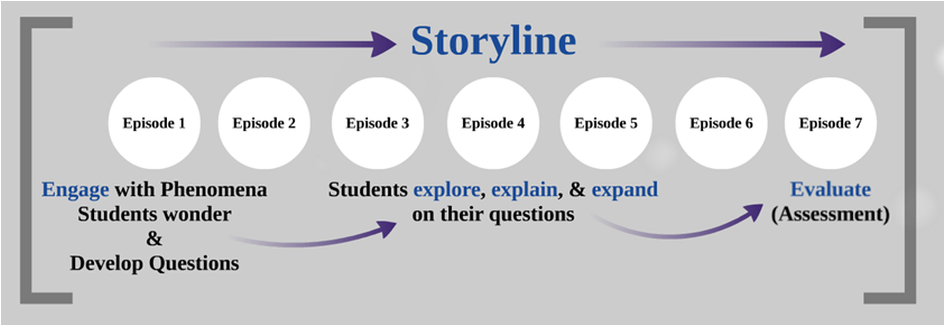
Popcorn is a "New World" food—it originated in the Americas and was unknown in the Eastern continents until after the voyage of Columbus. Just because it's called a "New World" food doesn't mean it's very new at all. In fact, the oldest ears of popcorn ever found were discovered at Bat Cave in west central New Mexico and are thought to be around 5,600 years old.2 Native tribes from North and South America relied on popcorn as an important food staple but also used it as a decoration. Cortez noted this in 1519 when he came into contact with the Aztecs, who used it to create exquisite decorations like ceremonial headdresses, necklaces, and ornaments on statues.
Americans today consume 13 billion quarts of popcorn each year, more than any country in the world.3 13 billion quarts averages out to about 42 quarts (40 L) or 10.5 gallons per person. Imagine 10.5 gallon milk containers full of popcorn for every person in the United States. That's a lot of popcorn! The majority of the popcorn consumed worldwide is grown in the Corn Belt of the United States covering Iowa, Illinois, Indiana, southern Michigan, western Ohio, eastern Nebraska, eastern Kansas, southern Minnesota, and Missouri. Nebraska is the top producer of popcorn.
Popcorn is a type of maize (corn) scientifically known as Sea mays everta. There are five different types of corn—sweet corn, popcorn, dent (field) corn, flour corn, and flint corn—but only one kind that pops...popcorn! Popcorn seeds are planted in the spring and take 7-10 days to germinate. The plant can grow to about 8 feet high and produce ears of corn covered in a green husk. Popcorn plants are wind pollinated. The pollen is located in the tassels at the top of the plant. The ears form silks that catch the pollen as the wind blows. The pollen travels down a small tube in each silk and fertilizes the ovule at the base. After successful fertilization, a kernel develops and the silk detaches.
The popcorn is ready to harvest when the kernels become hard and the stalk and leaves of the plant are brown and dry. Typically, a combine is used to harvest the popcorn. The ears are stripped from the stalk, and the kernels are shelled from the cob in the combine. The kernels are transported to a storage bin where they are dried until they reach the ideal moisture level of 14%. The kernels are then cleaned, polished, and packaged for distribution.
Popcorn is a grain composed of three parts—the pericarp (hull), germ, and endosperm. The pericarp is the hard outer shell surrounding the popcorn kernel. Inside the kernel is the germ, or seed embryo, and the endosperm. The endosperm contains trapped water and starch, which serves as food for the embryo during germination.
The popcorn kernel will pop when it is heated to an internal temperature of 400-460°F (204-238°C). When the kernel is heated, the moisture in the endosperm begins to boil and turns to steam. Because the pericarp is hard, pressure builds up inside the kernel. The starch gelatinizes and the moisture vaporizes until the pressure inside the kernel reaches 135 pounds per square inch. At this point the kernel bursts open and the starch solidifies to form the white, puffy part of popped popcorn. As the kernel turns inside out, the steam escapes.
One serving of popcorn provides about 70% of the recommended individual daily intake of whole grains. Popcorn also contains fiber, iron, and a number of essential vitamins. Per cup, popcorn contains 31 calories when air-popped, 55 calories when oil-popped, and 133 calories when lightly buttered. Popcorn is a healthy and nutritious whole grain snack option.
Engage
- Show the class the popcorn cob. Ask them if they know what kind of corn it is? (If you do not have a popcorn cob, show the class a container of Jiffy Pop popcorn or a bag of microwave popcorn. Ask the students what they think is inside the packaging.)
- Give each student an un-popped popcorn kernel to observe.
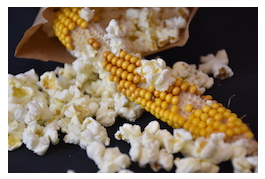
- With your students, pop popcorn right off the cob. Place the cob in a paper bag, fold the top of the bag down twice to secure the top, place in the center of a microwave, and heat on high power for 1-1/2 to 3-1/2 minutes (time will vary with the wattage of the unit). Stop the microwave when fast popping slows to 1-2 seconds between popping. Carefully open the bag. The cob is very HOT! Note: some kernels may not pop due to uneven heat distribution in the microwave. (If you are popping Jiffy Pop over a hot plate or microwave popcorn, follow the directions on the packaging.)
- Ask the students to describe what they observe. Discuss the steam that is present the moment the bag is opened.
- Give each student a piece of the popped popcorn to observe. Ask the students what differences they observe between the un-popped and popped popcorn.
- Ask the students, "How does popcorn pop?" After hearing their responses, let them know that this is a phenomenon worth investigating.
Explore and Explain
|
This lesson investigates the phenomenon of popcorn popping. Natural phenomena are observable events that occur in the universe that we can use our science knowledge to explain or predict. Phenomenon-Based Episode: How Does Popcorn Pop? |
Activity 1: Anatomy of a Popcorn Kernel (Episode Question 1)
- Organize the students into small groups. Have the students bring their un-popped and popped popcorn from the Engage activity to their groups. Provide each student with a copy of the Before, During, After graphic organizer.
- Ask the students to discuss the following question with their group, "What do you think happens to popcorn before, during, and after popping?"
- Instruct the students to record their ideas in the appropriate sections of the graphic organizer. Allow time for each group to share their ideas with the class.
- Explain to the students that in order to understand how popcorn pops, it is helpful to know more about the parts of a popcorn kernel, how it is grown, and how it differs from other types of corn.
- Choose from the following options to examine how popcorn is grown and the parts of a popcorn kernel.
- Review the Popcorn: Where Does it Come From and What is it Made Of? PowerPoint Slides.
- Watch the From Seed to Snack video.
- View the How It's Made: Popcorn video.
- Place the students back into their groups, and allow time for them to add to, revise, and/or question their original ideas on their graphic organizer. Share any additions, revisions, or questions with the whole group.
|
Three Dimensional Learning Proficiency: Crosscutting Concepts Students link different domains of science fields into a coherent and scientifically-based view of the world. Structure and Function: The way an object is shaped or structured determines many of its properties and functions. |
Activity 2: Exploring How Popcorn Pops (Episode Questions 2-4)
Safety Notes: There are risks involved when using an open flame and glass test tubes. Consider reviewing the Get Popping! video before you demonstrate this activity with the students. The following safety procedures should be practiced when performing the investigations in Activity 2:
- Roll up long sleeves
- Tie back long hair
- Wear safety glasses (everyone in the room)
- Keep work area clear
- Inspect the test tubes for cracks or damage (do not use the test tube if it is damaged)
- Make sure that the test tube glass is at room temperature before beginning the demonstration
- Keep the test tube opening pointed away from yourself and students
- Students should be at least 15 feet away from the demonstration
- Students should have observed steam as part of the Engage activity. Ask the students, "How is steam created?" (Steam is created when water is heated and liquid changes to gas—water vapor. When water vapor meets the colder air, it condenses into tiny water droplets suspended in air—steam.)
- Ask the students to consider how to design an experiment to observe water changing to steam using a test tube, water, a balloon, and a heat source. Discuss their ideas and guide the class until they come up with a procedure similar to the following.
- Put on safety glasses. Place four boiling stones into a test tube. Use the centrifuge tube to measure 3 mL of warm water, and pour the water into the test tube.
- Safety Note: To avoid boiling water entering the balloon and spraying out when the balloon pops, do not fill the test tube more than recommended. If boiling water begins to enter the balloon, immediately remove the test tube from the heat.
- Stretch out a small balloon by blowing it up a few times, and then stretch the balloon opening over the top of the test tube, pulling the balloon down over the top one inch of the tube. Light the alcohol lamp, put on a heat resistant glove, and use a test tube clamp to hold the test tube over, but not directly in, the flame of an alcohol lamp. Heat the water at a slight angle. Ask the students to predict what they think will happen as the water heats up.
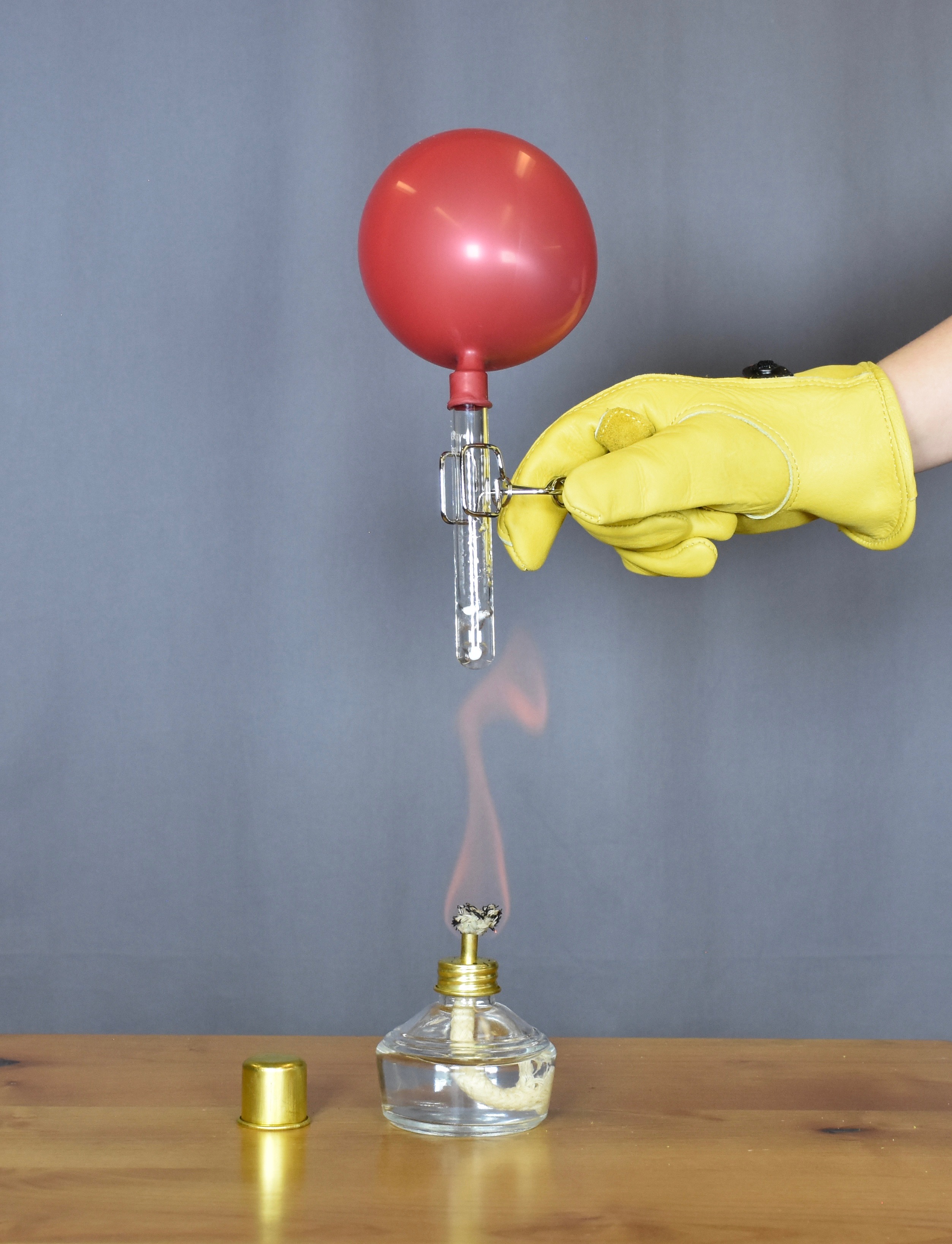 It will take about 45 seconds-1 minute for the water to begin to boil. At this point, hold the test tube straight up to allow the steam to enter the balloon. As the water reaches the boiling point, ask the students, "What are you observing?" (The water is changing to steam. The steam is expanding and trying to escape, inflating the balloon with its pressure.) Ask the students to predict what they think will happen to the balloon and why. (Eventually, the steam will create enough pressure to explode the balloon.) It will take about 1-1.5 minutes for the balloon to inflate and about 1.5-4 minutes or more for the balloon to pop.
It will take about 45 seconds-1 minute for the water to begin to boil. At this point, hold the test tube straight up to allow the steam to enter the balloon. As the water reaches the boiling point, ask the students, "What are you observing?" (The water is changing to steam. The steam is expanding and trying to escape, inflating the balloon with its pressure.) Ask the students to predict what they think will happen to the balloon and why. (Eventually, the steam will create enough pressure to explode the balloon.) It will take about 1-1.5 minutes for the balloon to inflate and about 1.5-4 minutes or more for the balloon to pop.- Extinguish the lamp's flame and place the hot test tube in a test tube stand or glass container to cool.
- Ask the students to diagram what they observed. Use the student diagrams to explain that all matter is made up of tiny parts called molecules. The arrangement of molecules differs in solids, liquids, and gases.
- Model the arrangement of molecules in solids, liquids, and gases using one of the following options.
- Have the students make fists with their hands, and push their fists tight together to demonstrate that the molecules in solids are tight together. Have the students rub their fists lightly together to demonstrate that molecules in liquids stick together, but can move around. Ask the students to think about what the steam was doing inside the balloon, and use their fists to demonstrate molecules in gases. The students should move their fists all over the place to demonstrate that molecules in gases move apart and take up any available space.
- Place students in small groups and provide each group with 8 circle sticky notes. Have the students arrange the sticky notes so that they are touching each other tightly together to demonstrate that the molecules in solids are tight together. Have the students arrange the sticky notes so that they are lightly touching each other to demonstrate that molecules in liquids stick together, but can move around. Ask the students to think about what the steam was doing inside the balloon, and use the sticky notes to demonstrate molecules in gases. The groups should arrange the sticky notes so that they are not touching each other and taking up as much space as possible on the desk to demonstrate that molecules in gases move apart and take up any available space.
- Provide each student with a handful of playdough. Ask the students to make 8 small balls of dough. Have the students arrange the playdough balls so that they are touching each other tightly to demonstrate that the molecules in solids are tight together. Have the students arrange the playdough balls so that they are lightly touching each other to demonstrate that molecules in liquids stick together, but can move around. Ask the students to think about what the steam was doing inside the balloon, and use the play dough balls to demonstrate molecules in gases. The students should arrange the playdough balls so that they are not touching each other and taking up as much room as possible on the desk to demonstrate that molecules in gases move apart and take up any available space.
- After modeling the molecules in solids, liquids, and gases, ask the students to explain how the steam made the the balloon expand and eventually burst. (As the water was heated and changed from liquid to gas (steam), the molecules in the steam moved apart to take up any available space, filling up the balloon and eventually causing enough pressure to burst it.)
- Review the parts of a popcorn kernel, and
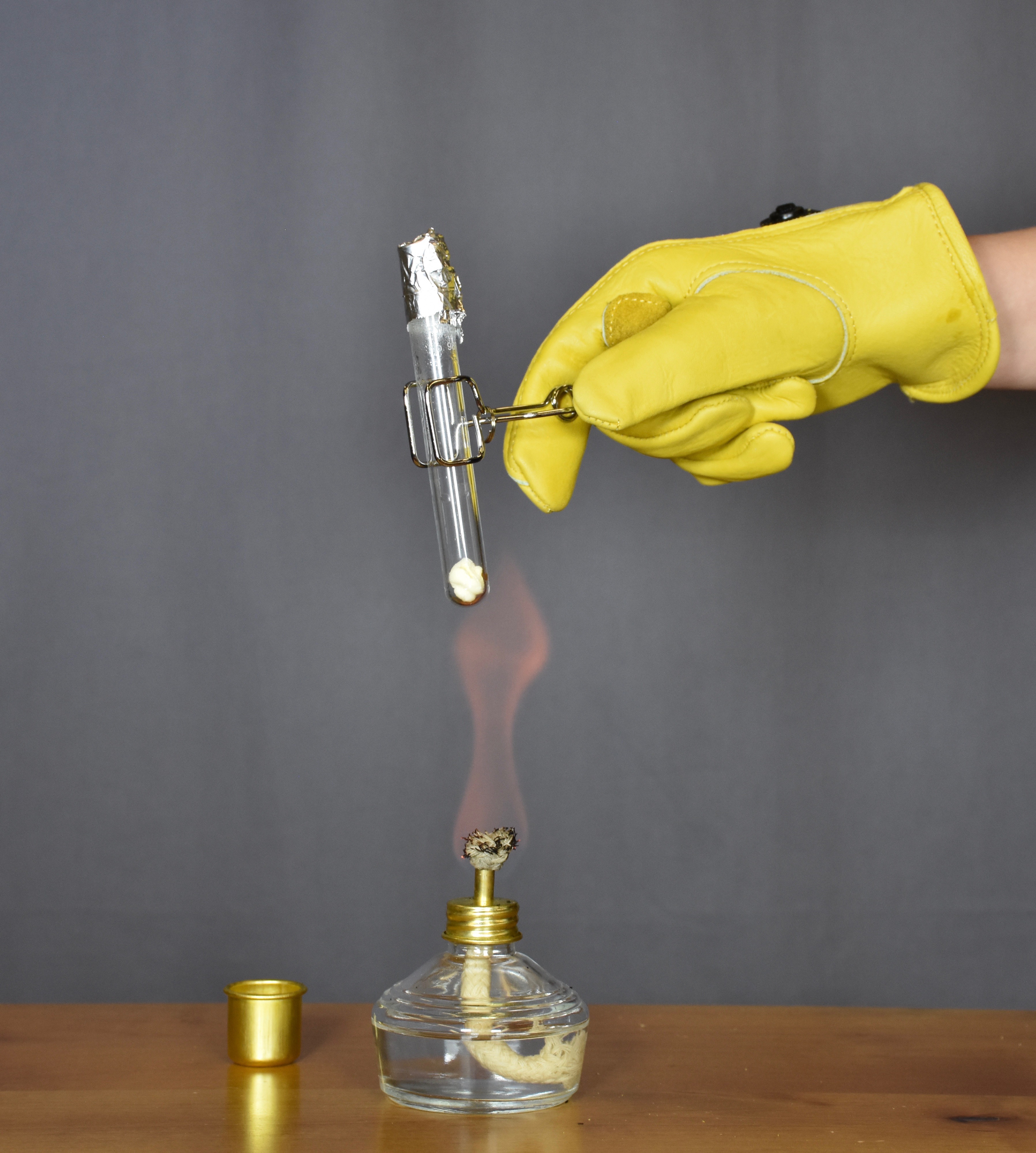 remind the students that popcorn kernels contain water. Ask them to predict and explain what will happen if a kernel of popcorn is heated in a test tube.
remind the students that popcorn kernels contain water. Ask them to predict and explain what will happen if a kernel of popcorn is heated in a test tube. - After hearing the predictions and explanations, put on safety glasses, place one kernel of popcorn and a drop of vegetable oil in a dry test tube, and cover the top of the test tube with aluminum foil. Put on a heat resistant glove, and use a test tube clamp to hold the test tube over the alcohol lamp flame. Shake the test tube to avoid burning the kernel. (Keep the top of the test tube pointed away from you and the students!) It will take about 45 seconds-1 minute for the kernel to pop.
- Extinguish the lamp's flame and place the hot test tube in a test tube stand or glass container to cool.
- To view popcorn popping in slow motion, show the class the Popping Popcorn in Ultra Slow Motion video.
- Clarify that each kernel of popcorn contains water stored inside a circle of soft starch. Ask the students to explain what they observed. (As the kernel heats up, the water inside the kernel boils and turns into steam. Because the pericarp is hard, pressure from the steam builds up inside the kernel. The starch gelatinizes and the pressure eventually becomes so great that the kernel bursts open and the starch solidifies to form the white, puffy part of the popcorn.)
- Ask the students to use their fists to demonstrate the water molecules inside the popcorn kernel, and then the steam molecules when the kernel was heated.
- Place the students back into their groups from Activity 1, and allow time for them to add to, revise, and/or question their original ideas on their graphic organizer. Share any additions, revisions, or questions with the whole group. Ask the students to share how their thinking changed and why. Use the completed graphic organizers to evaluate student understanding.
| If you put a cob of sweet corn in a microwave, will the kernels pop like popcorn? It's important to understand that different corn varieties are grown to meet various food and production needs. There are five different types of corn—dent corn, sweet corn, popcorn, flour corn, and flint corn—but only one kind that pops...popcorn! Sweet corn will not pop because, unlike popcorn, the kernels do not have a hard pericarp or the ideal moisture level inside. See the lesson Corn: An A-maizing Plant: Food, Fuel, and Plastic for more information about the different varieties of corn. |
|
Three Dimensional Proficiency: Crosscutting Concepts Students link different domains of science fields into a coherent and scientifically-based view of the world. |
Activity 3: Popcorn Nutrition
- Have the students bring in nutrition labels from their favorite snacks. Compare and contrast calories, fat, sugar, and vitamin content. Line the labels up in order of calorie content. Reorganize the labels in order of sugar content. Repeat with fat content. Ask the students to determine which snack food is healthiest overall.
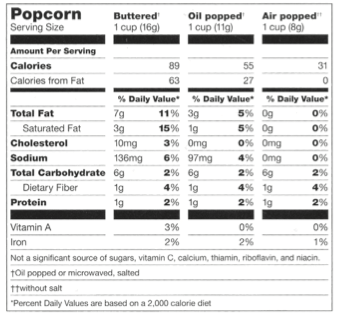 Put three cups of air-popped popcorn into a bowl, show it to students, and write the calorie content (93 calories) on the board.
Put three cups of air-popped popcorn into a bowl, show it to students, and write the calorie content (93 calories) on the board.- Hold up a stick of butter and write the calorie content (810 calories) on the board. Ask the students, "If you added one stick of butter to the popcorn, how many calories would that be in total?" (903 calories)
- Remind students that they should be mindful of the calories when adding butter to popcorn. It is possible to turn a healthy snack into an overly caloric "junk" food item.
- Explain to the students that popcorn is a whole grain, meaning it contains the entire whole grain kernel—the bran, germ, and endosperm. In contrast, a refined grain has been milled to remove the bran and germ which contain much of the dietary fiber, iron, and B vitamins. Popcorn can help you meet the recommendation to "make half of your grains whole."
- Share the following popcorn nutrition facts with the students:
- Per cup, popcorn contains 31 calories when air-popped, 55 calories when oil-popped, and 89 calories when lightly buttered.
- Popcorn is a whole grain. It provides energy-producing complex carbohydrates.
- Popcorn contains fiber, providing roughage the body needs in the daily diet.
- Popcorn has no artificial additives or preservatives and is sugar-free.
- Popcorn is ideal for between-meal snacking since it satisfies, but doesn't spoil, the appetite.
- Three cups of popcorn equals one serving from the grain group.
Elaborate
-
Popcorn seeds can be used as food for people, but they can also be sprouted and grown into new plants if given the chance. Explore germination by sprouting corn seeds using the Living Corn Necklace Kit or the Farming in a Glove (corn seeds) Kit.
-
Learn about a small family farm that is growing popcorn and selling the cobs at farmers' markets in this video.
-
Meet a popcorn farmer who lives on Popcorn Road by Popcorn Creek in Popcorn, Indiana in this video field trip of a real popcorn farm.
-
Pop popcorn in an air popper. Beforehand, ask students to predict whether the popped popcorn will weigh more or less than the popcorn kernels. Weigh the kernels in a bowl before popping and the popcorn in the same bowl after popping. The popped popcorn will weigh slightly less than the kernels. Explain that this is because the moisture inside the kernel escapes as steam when the popcorn pops. Add a little butter and salt to the popcorn and enjoy as a class snack.
Evaluate
- Ask the students the following questions:
- Does steam have energy? (yes)
- What evidence do we have to indicate that steam has energy? (Steam inflated and burst the balloon. Steam caused the popcorn kernel to pop.)
- Ask the students to consider some ways that steam energy might be harnessed and utilized. Use the information in the What is a Steam Power Plant? webpage to discover how steam energy is used in power plants.
- Review and summarize the following key concepts:
- Popcorn is a grain composed of three parts—the pericarp, germ, and endosperm. The endosperm contains water and starch.
- When water is heated, the water turns from a liquid to a gas—steam. Gas molecules move around and take up any available space.
- When a popcorn kernel heats up, the water in the endosperm boils and turns into steam. Pressure from the steam builds up inside the kernel, eventually becoming so great that the kernel bursts open.
- Popcorn is a healthy and nutritious whole grain snack option.
Sources
- http://www.popcorn.org/Facts-Fun/Corny-Facts
- https://specialcollections.nal.usda.gov/popcorn-exhibit#pop
- http://www.popcorn.org/Facts-Fun/History-of-Popcorn/Recent-Popcorn-History
Acknowledgements
- Storyline graphic from seedstorylines.org.
- Phenomenon chart adapted from work by Susan German.
German, S. (2017, December). Creating conceptual storylines. Science Scope, 41(4), 26-28.
German, S. (2018, January). The steps of a conceptual storyline. Science Scope, 41(5), 32-34. - Activity 3 was created for Utah Agriculture in the Classroom by Lyndi Perry.
Recommended Companion Resources
Author
Organization
| We welcome your feedback! If you have a question about this lesson or would like to report a broken link, please send us an email. If you have used this lesson and are willing to share your experience, we will provide you with a coupon code for 10% off your next purchase at AgClassroomStore. |
